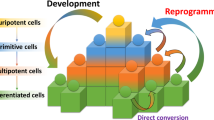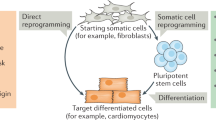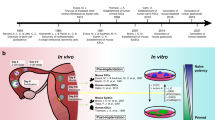Abstract
In 1998, two distinct and exciting scientific fields emerged which have profoundly shaped the current direction of biomedical research. The discovery of RNA interference (RNAi) and the derivation of human embryonic stem (ES) cells have yielded exciting new possibilities for researchers and clinicians alike. While fundamentally different, aspects from these two fields may be combined to yield extraordinary scientific and medical benefits. Here, we review the prospects of combining RNAi and ES cell manipulation for both basic research and future therapies, as well as current limitations and obstacles that need to be overcome.
This is a preview of subscription content, access via your institution
Access options
Subscribe to this journal
Receive 12 print issues and online access
$259.00 per year
only $21.58 per issue
Buy this article
- Purchase on Springer Link
- Instant access to full article PDF
Prices may be subject to local taxes which are calculated during checkout



Similar content being viewed by others
References
Fire A, Xu S, Montgomery MK, Kostas SA, Driver SE, Mello CC . Potent and specific genetic interference by double-stranded RNA in Caenorhabditis elegans. Nature 1998; 391: 806–811.
Napoli C, Lemieux C, Jorgensen R . Introduction of a chimeric chalcone synthase gene into petunia results in reversible co-suppression of homologous genes in trans. Plant Cell 1990; 2: 279–289.
Kumar M, Carmichael GG . Antisense RNA: function and fate of duplex RNA in cells of higher eukaryotes. Microbiol Mol Biol Rev 1998; 62: 1415–1434.
Elbashir SM, Harborth J, Lendeckel W, Yalcin A, Weber K, Tuschl T . Duplexes of 21-nucleotide RNAs mediate RNA interference in cultured mammalian cells. Nature 2001; 411: 494–498.
Yang S, Tutton S, Pierce E, Yoon K . Specific double-stranded RNA interference in undifferentiated mouse embryonic stem cells. Mol Cell Biol 2001; 21: 7807–7816.
Billy E, Brondani V, Zhang H, Muller U, Filipowicz W . Specific interference with gene expression induced by long, double-stranded RNA in mouse embryonal teratocarcinoma cell lines. Proc Natl Acad Sci USA 2001; 98: 14428–14433.
Wianny F, Zernicka-Goetz M . Specific interference with gene function by double-stranded RNA in early mouse development. Nat Cell Biol 2000; 2: 70–75.
Matzke MA, Birchler JA . RNAi-mediated pathways in the nucleus. Nat Rev Genet 2005; 6: 24–35.
Verdel A, Moazed D . RNAi-directed assembly of heterochromatin in fission yeast. FEBS Lett 2005; 579: 5872–5878.
Bernstein E, Allis CD . RNA meets chromatin. Genes Dev 2005; 19: 1635–1655.
McManus MT . Small RNAs and immunity. Immunity 2004; 21: 747–756.
Herr AJ . Pathways through the small RNA world of plants. FEBS Lett 2005; 579: 5879–5888.
Wang MB, Metzlaff M . RNA silencing and antiviral defense in plants. Curr Opin Plant Biol 2005; 8: 216–222.
Lagos-Quintana M, Rauhut R, Lendeckel W, Tuschl T . Identification of novel genes coding for small expressed RNAs. Science 2001; 294: 853–858.
Lau NC, Lim LP, Weinstein EG, Bartel DP . An abundant class of tiny RNAs with probable regulatory roles in Caenorhabditis elegans. Science 2001; 294: 858–862.
Lee RC, Ambros V . An extensive class of small RNAs in Caenorhabditis elegans. Science 2001; 294: 862–864.
Lee RC, Feinbaum RL, Ambros V . The C. elegans heterochronic gene lin-4 encodes small RNAs with antisense complementarity to lin-14. Cell 1993; 75: 843–854.
Hammond SM . Dicing and slicing: the core machinery of the RNA interference pathway. FEBS Lett 2005; 579: 5822–5829.
Tomari Y, Zamore PD . Perspective: machines for RNAi. Genes Dev 2005; 19: 517–529.
Hutvagner G . Small RNA asymmetry in RNAi: function in RISC assembly and gene regulation. FEBS Lett 2005; 579: 5850–5857.
Mansfield JH, Harfe BD, Nissen R, Obenauer J, Srineel J, Chaudhuri A et al. MicroRNA-responsive ‘sensor’ transgenes uncover Hox-like and other developmentally regulated patterns of vertebrate microRNA expression. Nat Genet 2004; 36: 1079–1083.
Yekta S, Shih IH, Bartel DP . MicroRNA-directed cleavage of HOXB8 mRNA. Science 2004; 304: 594–596.
Miyagishi M, Hayashi M, Taira K . Comparison of the suppressive effects of antisense oligonucleotides and siRNAs directed against the same targets in mammalian cells. Antisense Nucleic Acid Drug Dev 2003; 13: 1–7.
Kunath T, Gish G, Lickert H, Jones N, Pawson T, Rossant J . Transgenic RNA interference in ES cell-derived embryos recapitulates a genetic null phenotype. Nat Biotechnol 2003; 21: 559–561.
Caplen NJ . Gene therapy progress and prospects. Downregulating gene expression: the impact of RNA interference. Gene Therapy 2004; 11: 1241–1248.
Timmons L, Court DL, Fire A . Ingestion of bacterially expressed dsRNAs can produce specific and potent genetic interference in Caenorhabditis elegans. Gene 2001; 263: 103–112.
Timmons L, Fire A . Specific interference by ingested dsRNA. Nature 1998; 395: 854.
Xia H, Mao Q, Eliason SL, Harper SQ, Martins IH, Orr HT et al. RNAi suppresses polyglutamine-induced neurodegeneration in a model of spinocerebellar ataxia. Nat Med 2004; 10: 816–820.
Rubinson DA, Dillon CP, Kwiatkowski AV, Sievers C, Yang L, Kopinja J et al. A lentivirus-based system to functionally silence genes in primary mammalian cells, stem cells and transgenic mice by RNA interference. Nat Genet 2003; 33: 401–406.
Ventura A, Meissner A, Dillon CP, McManus M, Sharp PA, Van Parijs L et al. Cre-lox-regulated conditional RNA interference from transgenes. Proc Natl Acad Sci USA 2004; 101: 10380–10385.
Wiznerowicz M, Trono D . Conditional suppression of cellular genes: lentivirus vector-mediated drug-inducible RNA interference. J Virol 2003; 77: 8957–8961.
Stegmeier F, Hu G, Rickles RJ, Hannon GJ, Elledge SJ . A lentiviral microRNA-based system for single-copy polymerase II-regulated RNA interference in mammalian cells. Proc Natl Acad Sci USA 2005; 102: 13212–13217.
Tiscornia G, Tergaonkar V, Galimi F, Verma IM . CRE recombinase-inducible RNA interference mediated by lentiviral vectors. Proc Natl Acad Sci USA 2004; 101: 7347–7351.
Stewart SA, Dykxhoorn DM, Palliser D, Mizuno H, Yu EY, An DS et al. Lentivirus-delivered stable gene silencing by RNAi in primary cells. RNA 2003; 9: 493–501.
Pfeifer A . Lentiviral transgenesis. Transgenic Res 2004; 13: 513–522.
Cullen BR . Does RNA interference have a future as a treatment for HIV-1 induced disease? AIDS Rev 2005; 7: 22–25.
Shirane D, Sugao K, Namiki S, Tanabe M, Iino M, Hirose K . Enzymatic production of RNAi libraries from cDNAs. Nat Genet 2004; 36: 190–196.
Sen G, Wehrman TS, Myers JW, Blau HM . Restriction enzyme-generated siRNA (REGS) vectors and libraries. Nat Genet 2004; 36: 183–189.
Dinh A, Mo YY . Alternative approach to generate shRNA from cDNA. Biotechniques 2005; 38: 629–632.
Luo B, Heard AD, Lodish HF . Small interfering RNA production by enzymatic engineering of DNA (SPEED). Proc Natl Acad Sci USA 2004; 101: 5494–5499.
Evans MJ, Kaufman MH . Establishment in culture of pluripotential cells from mouse embryos. Nature 1981; 292: 154–156.
Martin GR . Isolation of a pluripotent cell line from early mouse embryos cultured in medium conditioned by teratocarcinoma stem cells. Proc Natl Acad Sci USA 1981; 78: 7634–7638.
Bradley A, Evans M, Kaufman MH, Robertson E . Formation of germ-line chimaeras from embryo-derived teratocarcinoma cell lines. Nature 1984; 309: 255–256.
Kleinsmith LJ, Pierce Jr GB . Multipotentiality of single embryonal carcinoma cells. Cancer Res 1964; 24: 1544–1551.
Stevens LC . The development of transplantable teratocarcinomas from intratesticular grafts of pre- and postimplantation mouse embryos. Dev Biol 1970; 21: 364–382.
Finch BW, Ephrussi B . Retention of multiple developmental potentialities by cells of a mouse testicular teratocarcinoma during prolonged culture in vitro and their extinction upon hybridization with cells of permanent lines. Proc Natl Acad Sci USA 1967; 57: 615–621.
Matsui Y, Zsebo K, Hogan BL . Derivation of pluripotential embryonic stem cells from murine primordial germ cells in culture. Cell 1992; 70: 841–847.
Resnick JL, Bixler LS, Cheng L, Donovan PJ . Long-term proliferation of mouse primordial germ cells in culture. Nature 1992; 359: 550–551.
Thomson JA, Itskovitz-Eldor J, Shapiro SS, Waknitz MA, Swiergiel JJ, Marshall VS et al. Embryonic stem cell lines derived from human blastocysts. Science 1998; 282: 1145–1147.
Shamblott MJ, Axelman J, Wang S, Bugg EM, Littlefield JW, Donovan PJ et al. Derivation of pluripotent stem cells from cultured human primordial germ cells. Proc Natl Acad Sci USA 1998; 95: 13726–13731.
Smith AG, Heath JK, Donaldson DD, Wong GG, Moreau J, Stahl M et al. Inhibition of pluripotential embryonic stem cell differentiation by purified polypeptides. Nature 1988; 336: 688–690.
Williams RL, Hilton DJ, Pease S, Willson TA, Stewart CL, Gearing DP et al. Myeloid leukaemia inhibitory factor maintains the developmental potential of embryonic stem cells. Nature 1988; 336: 684–687.
Ying QL, Nichols J, Chambers I, Smith A . BMP induction of Id proteins suppresses differentiation and sustains embryonic stem cell self-renewal in collaboration with STAT3. Cell 2003; 115: 281–292.
Xu RH, Chen X, Li DS, Li R, Addicks GC, Glennon C et al. BMP4 initiates human embryonic stem cell differentiation to trophoblast. Nat Biotechnol 2002; 20: 1261–1264.
Xu RH, Peck RM, Li DS, Feng X, Ludwig T, Thomson JA . Basic FGF and suppression of BMP signaling sustain undifferentiated proliferation of human ES cells. Nat Methods 2005; 2: 185–190.
Nichols J, Zevnik B, Anastassiadis K, Niwa H, Klewe-Nebenius D, Chambers I et al. Formation of pluripotent stem cells in the mammalian embryo depends on the POU transcription factor Oct4. Cell 1998; 95: 379–391.
Mitsui K, Tokuzawa Y, Itoh H, Segawa K, Murakami M, Takahashi K et al. The homeoprotein Nanog is required for maintenance of pluripotency in mouse epiblast and ES cells. Cell 2003; 113: 631–642.
Chambers I, Colby D, Robertson M, Nichols J, Lee S, Tweedie S et al. Functional expression cloning of Nanog, a pluripotency sustaining factor in embryonic stem cells. Cell 2003; 113: 643–655.
Velkey JM, O'Shea KS . Oct4 RNA interference induces trophectoderm differentiation in mouse embryonic stem cells. Genesis 2003; 37: 18–24.
Zaehres H, Lensch MW, Daheron L, Stewart SA, Itskovitz-Eldor J, Daley GQ . High-efficiency RNA interference in human embryonic stem cells. Stem Cells 2005; 23: 299–305.
Hay DC, Sutherland L, Clark J, Burdon T . Oct-4 knockdown induces similar patterns of endoderm and trophoblast differentiation markers in human and mouse embryonic stem cells. Stem Cells 2004; 22: 225–235.
Matin MM, Walsh JR, Gokhale PJ, Draper JS, Bahrami AR, Morton I et al. Specific knockdown of Oct4 and beta2-microglobulin expression by RNA interference in human embryonic stem cells and embryonic carcinoma cells. Stem Cells 2004; 22: 659–668.
Munsie MJ, Michalska AE, O'Brien CM, Trounson AO, Pera MF, Mountford PS . Isolation of pluripotent embryonic stem cells from reprogrammed adult mouse somatic cell nuclei. Curr Biol 2000; 10: 989–992.
Wakayama T, Perry AC, Zuccotti M, Johnson KR, Yanagimachi R . Full-term development of mice from enucleated oocytes injected with cumulus cell nuclei. Nature 1998; 394: 369–374.
Niwa H, Miyazaki J, Smith AG . Quantitative expression of Oct-3/4 defines differentiation, dedifferentiation or self-renewal of ES cells. Nat Genet 2000; 24: 372–376.
Hanna LA, Foreman RK, Tarasenko IA, Kessler DS, Labosky PA . Requirement for Foxd3 in maintaining pluripotent cells of the early mouse embryo. Genes Dev 2002; 16: 2650–2661.
Avilion AA, Nicolis SK, Pevny LH, Perez L, Vivian N, Lovell-Badge R . Multipotent cell lineages in early mouse development depend on SOX2 function. Genes Dev 2003; 17: 126–140.
Gerrard L, Zhao D, Clark AJ, Cui W . Stably transfected human embryonic stem cell clones express OCT4-specific green fluorescent protein and maintain self-renewal and pluripotency. Stem Cells 2005; 23: 124–133.
Ramalho-Santos M, Yoon S, Matsuzaki Y, Mulligan RC, Melton DA . ‘Stemness’: transcriptional profiling of embryonic and adult stem cells. Science 2002; 298: 597–600.
Keller G . Embryonic stem cell differentiation: emergence of a new era in biology and medicine. Genes Dev 2005; 19: 1129–1155.
Houbaviy HB, Murray MF, Sharp PA . Embryonic stem cell-specific MicroRNAs. Dev Cell 2003; 5: 351–358.
Murchison EP, Partridge JF, Tam OH, Cheloufi S, Hannon GJ . Characterization of Dicer-deficient murine embryonic stem cells. Proc Natl Acad Sci USA 2005; 102: 12135–12140.
Kanellopoulou C, Muljo SA, Kung AL, Ganesan S, Drapkin R, Jenuwein T et al. Dicer-deficient mouse embryonic stem cells are defective in differentiation and centromeric silencing. Genes Dev 2005; 19: 489–501.
Kyba M, Perlingeiro RC, Daley GQ . HoxB4 confers definitive lymphoid-myeloid engraftment potential on embryonic stem cell and yolk sac hematopoietic progenitors. Cell 2002; 109: 29–37.
Rideout III WM, Hochedlinger K, Kyba M, Daley GQ, Jaenisch R . Correction of a genetic defect by nuclear transplantation and combined cell and gene therapy. Cell 2002; 109: 17–27.
Wichterle H, Lieberam I, Porter JA, Jessell TM . Directed differentiation of embryonic stem cells into motor neurons. Cell 2002; 110: 385–397.
Miles GB, Yohn DC, Wichterle H, Jessell TM, Rafuse VF, Brownstone RM . Functional properties of motoneurons derived from mouse embryonic stem cells. J Neurosci 2004; 24: 7848–7858.
Kim JH, Auerbach JM, Rodriguez-Gomez JA, Velasco I, Gavin D, Lumelsky N et al. Dopamine neurons derived from embryonic stem cells function in an animal model of Parkinson's disease. Nature 2002; 418: 50–56.
Soria B, Roche E, Berna G, Leon-Quinto T, Reig JA, Martin F . Insulin-secreting cells derived from embryonic stem cells normalize glycemia in streptozotocin-induced diabetic mice. Diabetes 2000; 49: 157–162.
Hori Y, Rulifson IC, Tsai BC, Heit JJ, Cahoy JD, Kim SK . Growth inhibitors promote differentiation of insulin-producing tissue from embryonic stem cells. Proc Natl Acad Sci USA 2002; 99: 16105–16110.
He Z, Li J, Zhen C, Feng L, Ding X . Knockdown of p53 by RNAi in ES cells facilitates RA-induced differentiation into muscle cells. Biochem Biophys Res Commun 2005; 335: 676–683.
Zou GM, Chen JJ, Yoder MC, Wu W, Rowley JD . Knockdown of Pu.1 by small interfering RNA in CD34+ embryoid body cells derived from mouse ES cells turns cell fate determination to pro-B cells. Proc Natl Acad Sci USA 2005; 102: 13236–13241.
Koller BH, Hagemann LJ, Doetschman T, Hagaman JR, Huang S, Williams PJ et al. Germ-line transmission of a planned alteration made in a hypoxanthine phosphoribosyltransferase gene by homologous recombination in embryonic stem cells. Proc Natl Acad Sci USA 1989; 86: 8927–8931.
Thompson S, Clarke AR, Pow AM, Hooper ML, Melton DW . Germ line transmission and expression of a corrected HPRT gene produced by gene targeting in embryonic stem cells. Cell 1989; 56: 313–321.
Thomas KR, Capecchi MR . Targeted disruption of the murine int-1 proto-oncogene resulting in severe abnormalities in midbrain and cerebellar development. Nature 1990; 346: 847–850.
Thomas KR, Capecchi MR . Site-directed mutagenesis by gene targeting in mouse embryo-derived stem cells. Cell 1987; 51: 503–512.
Doetschman T, Gregg RG, Maeda N, Hooper ML, Melton DW, Thompson S et al. Targetted correction of a mutant HPRT gene in mouse embryonic stem cells. Nature 1987; 330: 576–578.
Lee NS, Rossi JJ . Control of HIV-1 replication by RNA interference. Virus Res 2004; 102: 53–58.
Jackson AL, Bartz SR, Schelter J, Kobayashi SV, Burchard J, Mao M et al. Expression profiling reveals off-target gene regulation by RNAi. Nat Biotechnol 2003; 21: 635–637.
Sledz CA, Holko M, de Veer MJ, Silverman RH, Williams BR . Activation of the interferon system by short-interfering RNAs. Nat Cell Biol 2003; 5: 834–839.
Bridge AJ, Pebernard S, Ducraux A, Nicoulaz AL, Iggo R . Induction of an interferon response by RNAi vectors in mammalian cells. Nat Genet 2003; 34: 263–264.
Gitlin L, Stone JK, Andino R . Poliovirus escape from RNA interference: short interfering RNA-target recognition and implications for therapeutic approaches. J Virol 2005; 79: 1027–1035.
Acknowledgements
We thank Jeremy F Reiter, Amander T Clark, David L Boone, and members of the McManus and Ramalho-Santos labs for critical reading of the manuscript.
Author information
Authors and Affiliations
Corresponding author
Rights and permissions
About this article
Cite this article
Heidersbach, A., Gaspar-Maia, A., McManus, M. et al. RNA interference in embryonic stem cells and the prospects for future therapies. Gene Ther 13, 478–486 (2006). https://doi.org/10.1038/sj.gt.3302723
Received:
Revised:
Accepted:
Published:
Issue Date:
DOI: https://doi.org/10.1038/sj.gt.3302723



